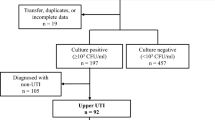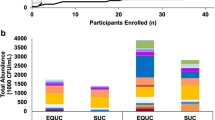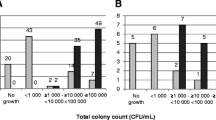Abstract
The clinical significance of low counts of enterococci in urine cultures remains unclear. The goal of this study was to investigate the clinical significance of enterococci growing in numbers lower than 100,000 colony-forming units per milliliter (cfu/ml) in urine samples. Clinical parameters were collected from patients whose midstream clean-catch urine samples grew Enterococcus spp. in amounts between ≥10,000 and 100,000 cfu/ml and who were not previously treated with antibiotics. Only those patients who had leukocyturia in addition to positive culture were considered to have true urinary tract infection (UTI). Of the 208 patients included in the study, 54% were diagnosed with true UTI. Patients with true UTI were older by 6 years (p=0.03), were more likely to be hospitalized (p=0.016), had higher rates of dysuria (p=0.0001), urgency (p=0.0001), and frequency (p=0.0001), and had more solid tumors (p=0.03). By multivariate analysis, urgency (OR=7.1) and hospitalization (OR=4.4) were identified as independent risk factors for true UTI with enterococci in low counts. Enterococcal counts in patients with true UTI were randomly distributed all along the scale between 10,000 and 100,000 cfu/ml, and no differential cutoff could be determined. In conclusion, more than half of the patients whose urine cultures grow Enterococcus spp. in counts lower than 100,000 cfu/ml may have true UTI, especially if they are hospitalized and have symptoms of dysuria, urgency, or frequency. Microbiology laboratories should perform a complete work-up on samples containing low counts of enterococci, and the final interpretation should be done by physicians, using additional clinical information.
Similar content being viewed by others
References
Patton JP, Nash DB, Abrytyn E (1991) Urinary tract infection: economic considerations. Med Clin North Am 75:495–513
Kass EH, Finland M (1956) Asymptomatic infections of the urinary tract. Trans Assoc Am Physicians 69:56–64
Stamm WE, Hooton M (1993) Management of urinary tract infections in adults. N Engl J Med 329:1328–1334
Lipsky A (1999) Prostatitis and urinary tract infections in men: what’s new, what’s true? Am J Med 106:327–334
Moellering RC Jr (1992) Emergence of Enterococcus as a significant pathogen. Clin Infect Dis 14:1173–1176
Felmingham D, Wilson AP, Quintana AI, Gruneberg RN (1992) Enterococcus species in urinary tract infection. Clin Infect Dis 15:295–301
Ruoff KL, de la Maza L, Murtagh MJ, Spargo JD, Ferraro MJ (1990) Species identities of enterococci isolated from clinical specimens. J Clin Microbiol 28:435–437
Jones RN, Kugler KC, Pfaller MA, Winokur PL (1999) Characteristics of pathogens causing urinary tract infections in hospitals in North America: results from the SENTRY Antimicrobial Surveillance Program, 1997. Diagn Microbiol Infect Dis 35:55–63
Griebling TL (2005) Urologic Diseases in America Project: trends in resource use for urinary tract infections in women. J Urol 173:1281–1287
Mathai D, Jones RN, Pfaller MA, and the SENTRY Participant Group North America (2001) Epidemiology and frequency of resistance among pathogens causing urinary tract infections in 1,510 hospitalized patients: a report from the SENTRY Antimicrobial Surveillance Program (North America). Diagn Microbiol Infect Dis 40:129–136
Laupland KB, Bagshaw SM, Gregson DB, Kirkpatrick AW, Ross T, Church DL (2005) Intensive care unit-acquired urinary tract infections in a regional critical care system. Crit Care 9:R60–R65
Laupland KB, Zygun DA, Davis HD, Church DL, Louie TJ, Doig CJ (2002) Incidence and risk factors for acquiring nosocomial urinary tract infection in the critically ill. J Crit Care 17:50–57
Langley JM, Hanakowski M, Leblanc JC (2001) Unique epidemiology of nosocomial urinary tract infection in children. Am J Infect Control 29:94–98
Moulin F, Quintart A, Sauvestre C, Mensah K, Bergeret M, Raymond J (1998) Nosocomial urinary tract infections: retrospective study in a pediatric hospital. Arch Pediatr 5(Suppl 3):274S–278S
Morrison AJ Jr, Wenzel RP (1986) Nosocomial urinary tract infections due to enterococcus. Ten years experience at a university hospital. Arch Intern Med 146:1549–1551
Bitsori M, Maraki S, Raissaki M, Bakantaki A, Galanakis E (2005) Community-acquired enterococcal urinary tract infections. Pediatr Nephrol 20:1583–1586
Ronald A (2002) The etiology of urinary tract infection: traditional and emerging pathogens. Am J Med 113(Suppl 1A):14S–19S
Tailor SA, Bailey EM, Rybak MJ (1993) Enterococcus, an emerging pathogen. Ann Pharmacother 27:1231–1242
Wong AH, Wenzel RP, Edmond MB (2000) Epidemiology of bacteriuria caused by vancomycin-resistant enterococci—a retrospective study. Am J Infect Control 28:277–281
Hooton TM (1990) The epidemiology of urinary tract infection and the concept of significant bacteriuria. Infection 18(Suppl 2):S40–S43
Hummers-Pradier E, Ohse AM, Koch M, Heizmann WR, Kochen MM (2004) Int J Clin Pharmacol Ther 42:360–366
Barnett BJ, Stephens DS (1997) Urinary tract infection: an overview. Am J Med Sci 314:245–249
Acknowledgement
Mrs. Idit Lavie is gratefully acknowledged for her assistance with the statistical processing of the data.
Author information
Authors and Affiliations
Corresponding author
Rights and permissions
About this article
Cite this article
Colodner, R., Eliasberg, T., Chazan, B. et al. Clinical significance of bacteriuria with low colony counts of Enterococcus species. Eur J Clin Microbiol Infect Dis 25, 238–241 (2006). https://doi.org/10.1007/s10096-006-0132-0
Published:
Issue Date:
DOI: https://doi.org/10.1007/s10096-006-0132-0




